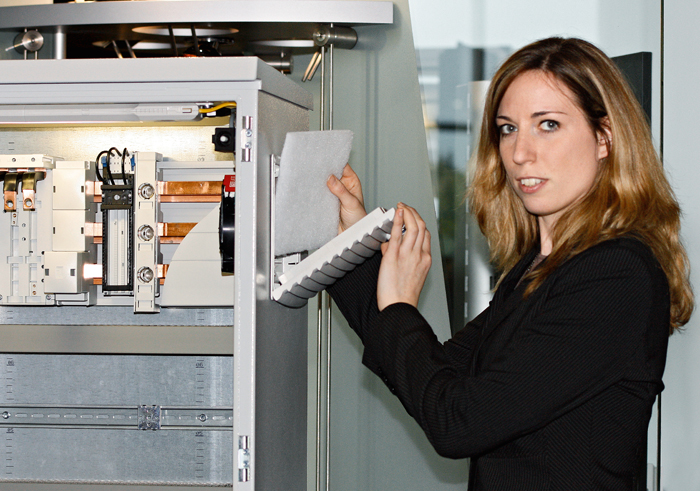It is crowded in the control cabinet – and it gets hot. More and more electronic components have to find space in there. Due to the heat given off, hot spots of up to over 90°C exist. Sensitive electronic components have their service life significantly limited or, in a worst-case scenario, are destroyed by the heat. Filter fans take care of the needed cooling. They are composed of a fan and a dust filter that prevents dirt particles from getting into the cabinet. Underneath, embedded in the door of the control cabinet, the filter fan blows cold air towards the inside. It absorbs the heat, causes it to rise and sends it back out through an air exhaust grille.
High-performance cooling
In the filter fans of control cabinet technology supplier Rittal, the axial fans transport the air from outside to inside. “These axial fans have their optimum operating range in low static counterpressure, where they deliver relatively large air volumes,” explains Thomas Heli, responsible Head of Development Product range EA-2 at ebm-papst in Mulfingen. Should resistance increase, for example because of a dirty filter mat, the efficiency decreases: the flow breaks off at the impeller and there can be turbulence. “This makes the fans inefficient and noisy,” says Heli. Together with Rittal, the developers at ebm-papst sought a new solution. The result: a new diagonal fan series, special for the TopTherm filter fans of the leading worldwide system supplier Rittal. “For the user, a high and constant air performance is particularly important”, explains Christine Ronzheimer, product manager and project manager for air-conditioning at Rittal. “Aside from that, the fans should be simple to install without tools and be service and maintenance-friendly as well.”
With these specifications, the teams from Mulfingen and St. Georgen went to work: “We quickly recognized that the axial fans used for this application are not the optimal solution. The compact diagonal fans are much better suited to this,” states Heli. They unite the positive properties of axial and centrifugal fans. “The air flow direction of the diagonal compact fan is, as with the axial compact fans, mostly axial. The pressure build-up is, however, increased by the additional centrifugal exhaust component.” Through this diagonal exhaust, the interior of the control cabinet is simultaneously cooled and the build-up of hot spots reduced.
Energy-saving and service-friendly
The diagonal fans have further advantages: In the event of a dirty filter mat, performance degradation is significantly lower despite the higher counterpressure. The mat has to be changed less often and the maintenance intervals are lengthened. Moreover, the new fans save a significant amount of energy – above all, when they are controlled over an additional thermostat: “The control cabinets will be cooled significantly more effectively with the new diagonal ventilators. With an additional regulator it can have a significantly shorter run time and an up to 48 percent reduction in energy consumption,” Ronzheimer emphasizes.
Heli makes clear what that means in the real world: “In a production hall with 200 filter fans, you would save 26,600 kilowatt hours and about 3,000 EUR in energy costs annually. Viewed over a usage time frame of five years, that amounts to 15,000 EUR.” In order to connect the diagonal fans to the filter frame, the fans are integrated in an innovative housing which, along with the motor bracket with integrated guard grilles, also includes the receptacle of the connection terminal and an integrated bayonet coupling.
Thanks to this bayonet coupling, the fan is quick to mount: position, turn – all without tools. The direction of air flow can also be changed without much effort. “The cold air should not just be pushed inward, otherwise the warm air has to be actively extracted by suction, and the direction of air flow has to be changed,” explains Christine Ronzheimer. “Up till now, this required great effort.” Now, the ventilator can be easily released via the bayonet coupling, turned 180° and reinstalled. A further plus: “With the old fan, the terminal clamps were always fixed in one corner. In extreme cases, the customer had to wrap the supply around the entire fans,” said the product manager. “Now they can position the terminal clamp flexibly in one of four corners – they simply turn the fan.” Quick to mount, the filter fan then takes care of optimum cooling, even in fully packed control cabinets.



Leave a comment